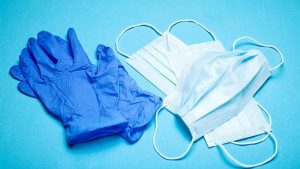
The coronavirus (COVID-19) epidemic continues in the UK. As we move to the “recovery phase” or the “new normal” as it is often referred to, employers are expected to plan for the return to work of employees where they are not able to work from home.
The UK Government has published COVID-19 Secure working safely guidance for workplaces that provides a hierarchy of risk control measures that employers and the self-employed are expected to follow when reviewing their risk assessments for COVID-19 hazards.
“When managing the risk of COVID-19, additional PPE beyond what you usually wear is not beneficial. This is because COVID-19 is a different type of risk to the risks you normally face in a workplace, and needs to be managed through social distancing, hygiene and fixed teams or partnering, not through the use of PPE.
“Workplaces should not encourage the precautionary use of extra PPE to protect against COVID-19 outside clinical settings or when responding to a suspected or confirmed case of COVID-19.
“Unless you are in a situation where the risk of COVID-19 transmission is very high, your risk assessment should reflect the fact that the role of PPE in providing additional protection is extremely limited.
“However, if your risk assessment does show that PPE is required, then you must provide this PPE free of charge to workers who need it. Any PPE provided must fit properly.”
Note: Where an employer is required to provide PPE in relation to the mitigation of transmission risks from COVID-19, the requirements of the Personal Protective Equipment at Work Regulations 1992 will apply.
The UK Government has published a Coronavirus (COVID-19): Personal Protective Equipment (PPE) Plan. This contains guidance on who needs PPE, what type of PPE is required and in what circumstances. It states that PPE is “a precious resource and must be used only where there is a clinical need to do so”.
In summary, the guidance recommends that:
The guidance then states: “Beyond these roles, the current clinical evidence says there is not a widespread benefit from wearing PPE. Instead, the best way to protect yourself and others is to regularly wash your hands and to keep at least two metres between you and other people whenever you leave your house”.
The guidance on Cleaning of Non-healthcare Settings states the following.
“The minimum PPE to be worn for cleaning an area where a person with possible or confirmed coronavirus (COVID-19) has been is disposable gloves and an apron. Hands should be washed with soap and water for 20 seconds after all PPE has been removed.
“If a risk assessment of the setting indicates that a higher level of virus may be present (for example, where unwell individuals have slept such as a hotel room or boarding school dormitory) or there is visible contamination with body fluids, then the need for additional PPE to protect the cleaner’s eyes, mouth and nose might be necessary. The local Public Health England (PHE) Health Protection Team (HPT) can advise on this.
“Non-healthcare workers should be trained in the correct use of a surgical mask, to protect them against other people’s potentially infectious respiratory droplets when within 2 metres, and the mask use and supply of masks would need to be equivalent to that in healthcare environments.”
The Government’s COVID-19 Secure guidance states that covering the face may be “marginally beneficial as a precautionary measure”. The evidence indicates that wearing a face covering does not protect the wearer but may protect others if you are carrying the virus.
Face coverings are not a substitute for other forms of risk control in the workplace.
The guidance states: “Wearing a face covering is optional and is not required by law, including in the workplace. If you choose to wear one, it is important to use face coverings properly and wash your hands before putting them on and taking them off.”
Optional use includes on public transport and in some shops or other “enclosed spaces where social distancing is not always possible” and where individuals might come into contact with others that they do not normally meet.
If you require further information, on risk assessments for COVID-19 or any other topic, please contact us.